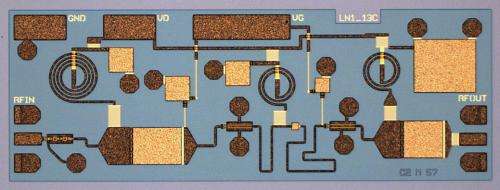Cooled integrated circuit amplifies with lowest noise so far

Researchers at Chalmers University of Technology, Sweden, have demonstrated an integrated amplifier with the lowest noise performance so far. The amplifier offers new possibilities for detecting the faintest electromagnetic radiation, for example from distant galaxies.
Last year, Chalmers reported a world record for a low-noise amplifier in the prestigious journal Electron Device Letters. The amplifier exhibited a minimum noise figure of 0.018 dB across a bandwidth of 4-8 GHz. However, since the low-noise amplifier was designed in a hybrid solution, scaling up to larger quantities turned out to be very difficult.
Chalmers has now in collaboration with a company called Low-Noise Factory published an article on an integrated ultra-low-noise amplifier. The scientists have developed a unique indium phosphide-based process for what is known as high electron mobility transistors (HEMT). Transistors and other semiconductor components have been fabricated on a monolithic chip on an indium phosphide wafer. All parts of the design such as semiconductor layers, components, process and circuit design have been optimised for the lowest noise performance.
As a result, an integrated 2.0 x 0.75 mm amplifier with an ultra-low-noise figure of 0.045 dB was demonstrated. The amplifier had a very large bandwidth of 0.5-13 GHz and a high gain exceeding 38 dB across the frequency band. In order to show such extreme performance, the amplifier was cooled to minus 260 degrees of Celsius.
"The combination of high gain, large bandwidth and ultra-low-noise figure makes this circuit very attractive for large multipixel arrays containing thousands of antennas," says Jan Grahn, research group leader at Chalmers.
"The integrated ultra-low-noise process enables the fabrication of thousands of amplifiers with identical performance. One potential future application is in the world's largest radio telescope SKA (Square Kilometer Array) that is being planned, an international project where the Onsala Space Observatory at Chalmers is one of the acting members. In huge applications such as the SKA, even a small noise-figure reduction in the first low-noise amplifier in the receiver chain may potentially bring about major savings in the final system design."
More information: IEEE transactions on microwave theory and techniques, 61 ( 2 ) s. 871-877 ieeexplore.ieee.org/stamp/stam … tp=&arnumber=6403592
Provided by Chalmers University of Technology





















